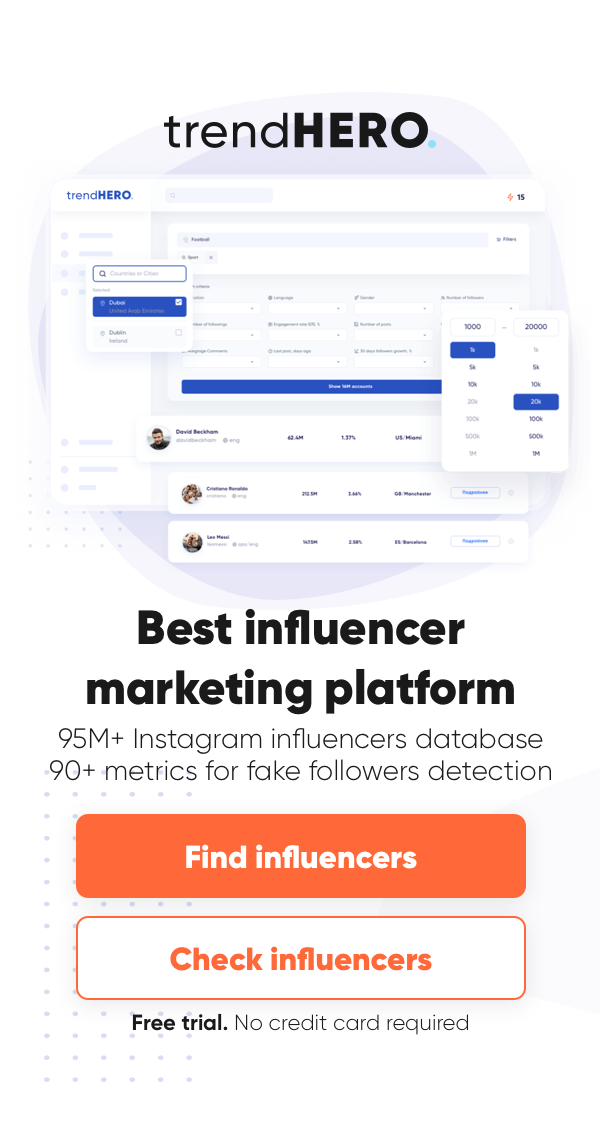- Home
- BLOG
- Instagram Marketing
- Influencer Marketing ROI: Measuring Success and Overcoming Challenges
In the dynamic world of digital marketing, influencer marketing has emerged as a powerful strategy. It leverages the reach and credibility of influencers to promote products and services, creating authentic connections with audiences.
But as with any marketing strategy, it’s crucial to understand its effectiveness.
There are two main challenges covered in this article:
- How to measure ROI from influencer marketing campaigns.
- Compare your influencer marketing ROI with other channels and brands.
In this article, we’ll also delve into the intricacies of influencer marketing ROI, why it’s important, and how you can measure and maximize it for your campaigns.
What is Influencer Marketing ROI
ROI means Return on Investment or ‘how much I get for every invested dollar’.
Influencer marketing ROI is a measure of the returns your business gains from its influencer marketing campaigns relative to the cost of those campaigns. It’s a critical metric that helps you understand the effectiveness of your influencer marketing efforts.
Widely spread formula for ROI is:
ROI = Net income / Cost of investment x 100%.
There is also formula for Return of Marketing Investment:
ROMI = (Marketing revenue — Marketing expenses) / Marketing expenses x 100%
In this article we’ll use the formula:
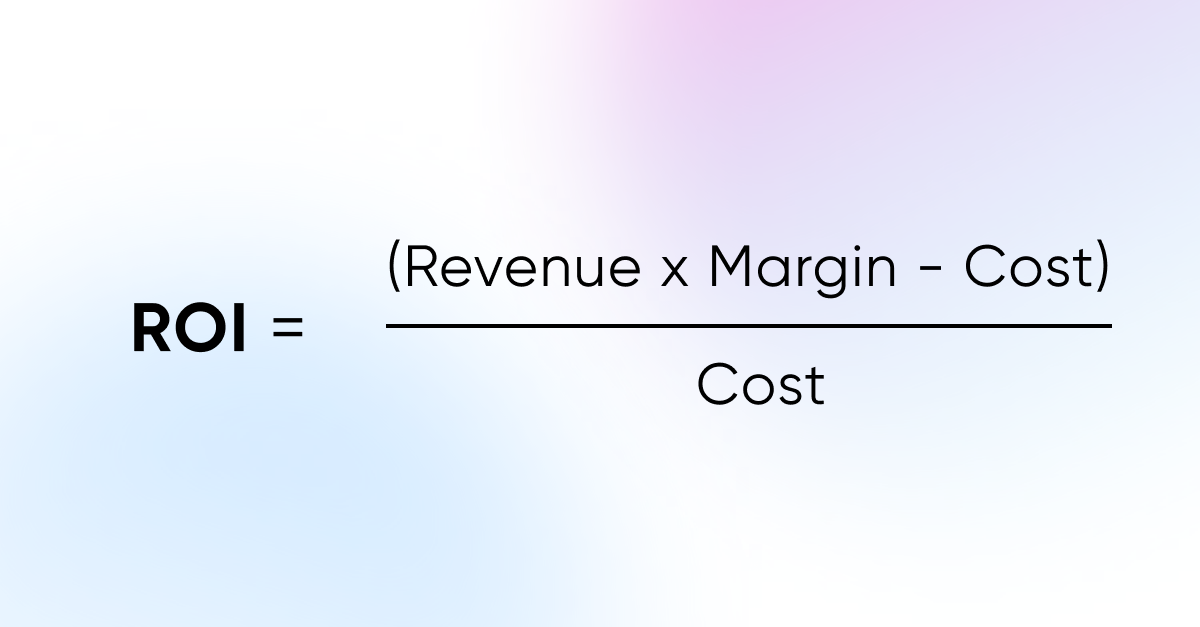
IM ROI = (Revenue x Margin — Cost) / Cost x 100%.
And we don’t include social media management and influencer manager salary in costs. Ad budget only.
How to Calculate Influencer Marketing ROI (Examples)
In a real life there are wins and fails. If you perform digital marketing, you know that sometimes your campaign can bring near zero results. So it’s a good practice to do this:
- calculate influencer campaign ROI. For example, we used formula ROI = (Revenue x Margin – Cost) / Cost, where margin is 10% for our business:
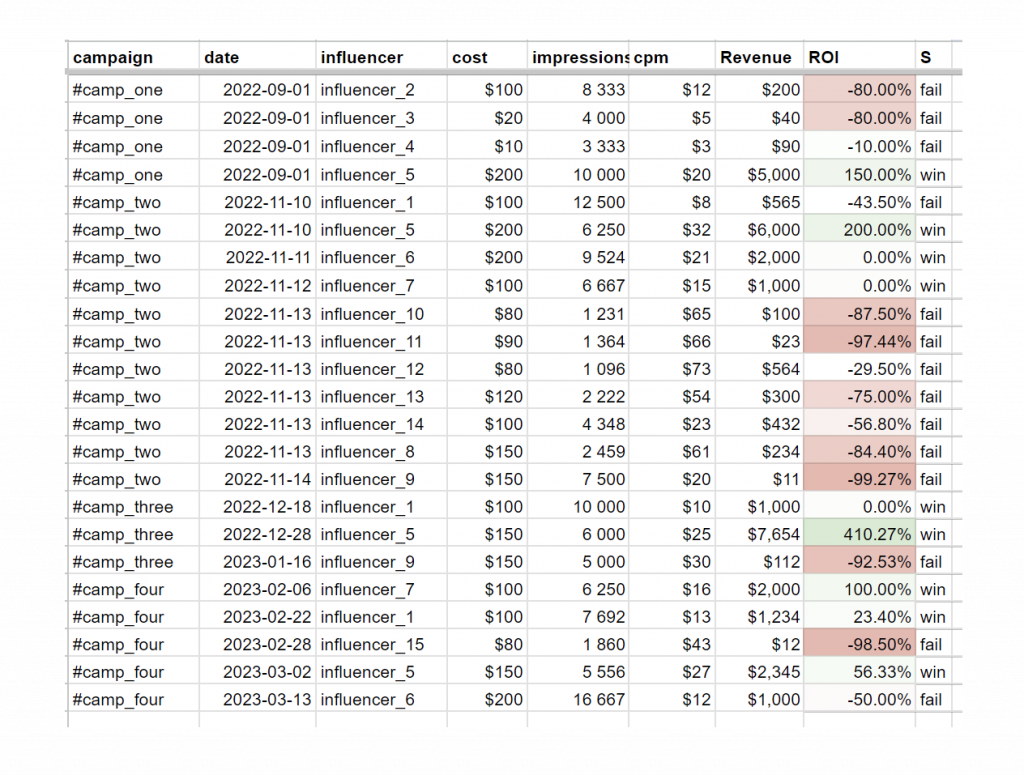
- measure overall monthly ROI:

- check successful campaigns part of budget (ROI>0 means that campaign is successful):

Why we use ‘Revenue x Margin’ for this ROI formula?
To calculate ROI we need to know Profit or Net income. ‘Revenue * Margin’ is the simplest way to know it for a marketer in ecommerce.
The most awkward mistake we can make use Revenue in this formula.
Example: We paid $1000 for promo. We have 10 orders $200 each. Our margin for these goods is 35%. So now we can compare:
- ROI = (Revenue – Cost)/Cost = (2 000 – 1 000) / 1 000 = 1$. It means that we got one additional dollar for each invested dollar.
- ROI = (Revenue x Margin – Cost)/Cost = ((2 000 x 0.35) – 1 000) / 1 000 = -0.3$. It means that we lost 30 cents for each invested dollar.
The first way to calculate ROI is just a way to trick yourself.
ROI is calulated in % or dollars?
Both ways.
ROI -0.3$ means that you lost 30 cents for each invested dollar. Or you can say ROI -30%. It means that you lost 30% of your investment. The author of this article prefers using dollars as ROI unit of measurement.
- ROI -1$ of lower – means that you lost all your investment.
- ROI 0$ – means that you get all you investment back.
- ROI 1$ – means that you earn +100%.
What is good influencer ROI?
There are poll results about average ROI:
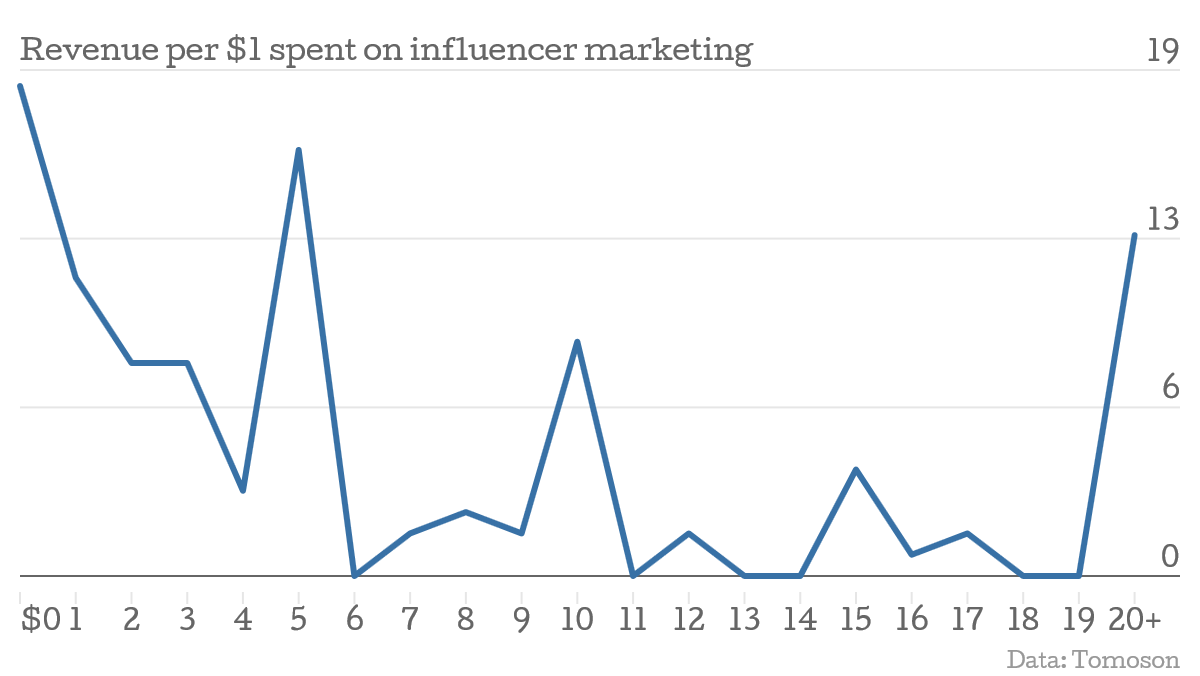
It means that they asked marketers what is their ROI and find out that average ROI for influencer marketing is $6,5.
6.5$ or 650%.
But I won’t be upset to have overall yearly ROI from 20%.
Remember, the specific metrics you use to measure ROI will depend on your campaign goals. For example, if your goal is to increase sales, you might track the number of purchases made using a unique promo code provided by the influencer. If your goal is to increase brand awareness, you might measure the number of impressions or the reach of your campaign.
How to Measure Influencer Marketing ROI
Measuring the ROI of influencer marketing involves several steps and key metrics. Let’s start with a guide, and then talk about challenges. Here’s a step-by-step guide:
- Define Your Goals: Before you can measure ROI, you need to define what success looks like for your campaign. This could be increasing brand awareness, driving website traffic, generating leads, or boosting sales.
- Track Your Costs: Keep a record of all the costs associated with your influencer marketing campaign. This includes payments to influencers, cost of products or services given away, and any additional expenses like production costs for content.
- Identify Key Performance Indicators (KPIs): These are the metrics that align with your campaign goals. They could include metrics like impressions, clicks, conversions, or sales.
- Collect Data: Use tracking tools and analytics to collect data on your KPIs. This could involve using tracking links, promo codes, or surveys to track the actions taken by your audience.
- Calculate ROI: The basic formula for ROI is (Return – Investment) / Investment * 100%. In the context of influencer marketing, the ‘return’ would be the value of the KPIs you’ve tracked, and the ‘investment’ would be the total cost of your campaign.
What Goals You Can Track to Measure Influencer Marketing ROI
- Conversions: leads, signups, orders, deals, form submissions. Revenue overall
- Views: Website traffic, profile and landing views, content impressions. Followers or non-followers views.
- Engagement: likes, comments, saves, shares
- Earned media value
- Followers: growth, coverage, cross-following, etc.
- Other: number of backlinks, etc.
Challenges in Measuring Influencer Marketing ROI
Despite its many benefits, measuring the ROI of influencer marketing can present some challenges.
| Step | Challenges |
|---|---|
| Define Your Goals |
|
| Track Your Costs |
|
| Identify KPIs |
|
| Collect Data |
|
| Calculate ROI |
|
Here are a few common solutions:
- Attribution: It can be difficult to directly attribute sales or conversions to a specific influencer marketing campaign, especially if you’re running multiple campaigns at once.
- You need to use Google Analytics and UTM links.
- Using unique promo codes or tracking links can help with attribution.
- You also need to link the client’s data with their social media accounts, or at least trea.
- Check the number of brand search queries during your influencer marketing campaigns.
- Long-Term Impact: The impact of influencer marketing can often be long-term, such as increased brand awareness or improved brand reputation. These benefits can be difficult to quantify and may not be immediately reflected in your ROI.
- Conducting surveys or using brand tracking tools can help measure long-term impact.
- For SaaS brands it’s vital to store the data abount acquisition source.
- Tools: to calculate ROI you need to use a bunch of integrated tools to know exactly wthat’s going on. But we can identify two approaches to measuring ROI:
- Basic: We’ve spent $1000 on collaboration. We’ve got 143 orders $200 each with a 10% margin. (((73*$200)*10%) – $1000)/$1000 *100% = 46%. It can be translated as ‘for every dollar we invested we’ve got 46 cents additionally’. Looks great until we add manager time to expenses;) But it’s okey when we compare different campaigns. In this case we don’t need a advanced tools. Google analytics with eCommerce measurement + Google sheets.
- Complex: One platform with user-centric model where we can track all customers’ activities and tell what exactly ammount of money we’ve spent on their acquisition.
There is also one more method to measure collaboration impact to calculate influencer marketing ROI.
Control groups:
- Take equal groups of your customers (e.g. 1000 customers).
- The first group should be following the influencer you want to collaborate with.
- The second group should be following a similar influencer out of your campaign.
- And you obviously need a control group with no data about their accounts.
- Check their activities after collaboration.
So you can check demand after collaboration and extrapolate. For instance, you see that group one spent $300, group two spent $200, and control group spent $150. So you can assume that every engaged thousand of followers generated 1.5x more revenue.
But it works only for big brands with large databases with linked social media data.
With the right strategies and tools, you can accurately measure and maximize your influencer marketing ROI.
Why is it important to measure ROI in influencer marketing?
The answer is simple: it allows you to quantify the value of your influencer marketing campaigns. By calculating ROI, you can:
- determine whether your investment in influencer marketing is paying off;
- identify areas of improvement;
- make data-driven decisions to optimize your future campaigns.
Understanding and measuring influencer marketing ROI can be a game-changer for businesses. It can provide valuable insights into the profitability of your marketing strategies and help you allocate your marketing budget more effectively.
Comparing Influencer Marketing ROI to Other Marketing Strategies
If we google, we can see something like: ‘Influencer marketing has 11X ROI‘. Or according to Statistica, 60% of marketers agree that influencer marketing has a higher ROI than traditional advertising. Where these numbers come from?
It’s often case studies of successful campaigns.
‘Hi! We are a very good agency. We did a great job for our client. They pay small amount of money and get huge ammount of money. We did these steps. And we could do this for you, too’.
Sorry for my sarcasm.
I am very skeptical about this, because one successful campaign isn’t enough for such statements.
The truth is that every channel works if you pay enough attention and make enough efforts.
Influencer marketing has become a key component of many businesses’ marketing strategies, and for good reason. When compared to traditional online advertising or other marketing strategies, influencer marketing often delivers a higher ROI.
Here are the comparison according to a poll of marketing professionals conducted by Tomoson:
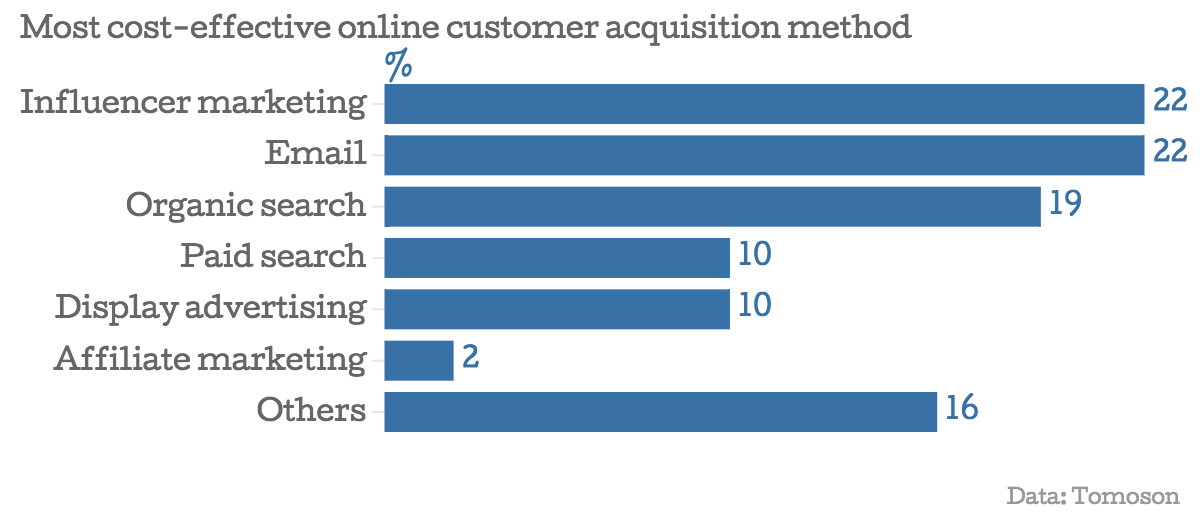
Why is this the case? Influencers have a unique ability to create authentic connections with their audiences. They are trusted figures who can sway their followers’ purchasing decisions. This trust can translate into higher engagement rates and more conversions, leading to a higher ROI.
But the benefits of influencer marketing extend beyond ROI. Influencer marketing can also boost brand awareness, improve brand reputation, and reach niche markets that might be difficult to target through other marketing channels. These benefits, while harder to quantify, can have a significant impact on your business’s long-term success.
The other side of the coin is time and efforts.
- Influencer Marketing vs. Paid Ads:
- IM leverages the trust and authenticity that influencers have built with their audience.
- IM can often lead to higher engagement and conversion rates compared to paid ads, which are often seen as more intrusive.
- IM requires careful selection of influencers and is harder to control and measure than paid ads.
- IM ROI is more complex to calculate and a midle-term thing. There are such benefits as followers and brand awareness, that don’t always measure for ROI.
- Influencer Marketing vs. SEO:
- SEO is a long-term strategy that involves optimizing your website to rank higher in search engine results, driving organic traffic over time.
- IM can provide more immediate results in terms of brand awareness and sales.
- SEO can deliver sustained traffic over time without the ongoing costs associated with influencer marketing.
- Minimal SEO investments are usually higher.
- IM generates much more relevant traffic. You can’t compare 1000 views from Google search and from a influencer.
- Influencer Marketing vs. Email Marketing:
- EM involves sending direct messages to customers who have opted in to receive them. It’s a great tool for nurturing leads and driving repeat purchases.
- IM can help you reach new audiences and boost brand awareness more effectively.
- Both strategies can be part of a balanced marketing mix, with email marketing maintaining relationships with existing customers and influencer marketing attracting new ones.
Maximizing Influencer Marketing ROI
To get the most out of your influencer marketing campaigns and maximize ROI, consider the following strategies:
- Choose the Right Influencers: Not all influencers are created equal. Look for influencers who align with your brand values, have a genuine connection with their audience, and have a track record of successful partnerships.
- Set Clear Goals and KPIs: As mentioned earlier, having clear goals and KPIs is crucial for measuring ROI. It also helps you design more effective campaigns.
- Create Authentic Content: Authenticity is key in influencer marketing. Allow influencers to create content that resonates with their audience and aligns with their unique style and voice.
- Leverage Multiple Platforms: Don’t limit yourself to one platform. Different platforms have different audiences and strengths, so diversify your influencer marketing efforts.
- Analyze and Optimize: After each campaign, analyze your results and identify areas for improvement. Use these insights to optimize your future campaigns.
By implementing these strategies, you can improve your influencer marketing campaigns and boost your ROI.
Leveraging Tools to Measure Influencer Marketing ROI
In today’s digital age, there are numerous tools available that can help you measure and optimize your influencer marketing ROI. These tools can provide valuable insights into your campaign performance, track key metrics, and help you make data-driven decisions.
One such tool is trendHERO. This platform provides in-depth analytics for influencer marketing campaigns, helping businesses identify the right influencers, track campaign performance, and measure ROI. With features like influencer search and discovery, audience analytics, and campaign tracking, trendHERO can be a game-changer for businesses looking to maximize their influencer marketing ROI.
Conclusion
Influencer marketing has become an integral part of many businesses’ marketing strategies. With its potential for high ROI and its ability to create authentic connections with audiences, it’s no surprise that more and more businesses are investing in influencer marketing.
However, as with any marketing strategy, it’s crucial to measure and understand your ROI. By defining clear goals, tracking key metrics, and leveraging tools like trendHERO, you can accurately measure your influencer marketing ROI and make data-driven decisions to optimize your campaigns.
Remember, the success of your influencer marketing campaigns isn’t just about ROI. It’s also about building brand awareness, improving brand reputation, and creating genuine relationships with your audience. So, while ROI is important, don’t lose sight of these other valuable benefits.
We also recommend to read
Instagram Engagement Rate Calculator For Free
Check any influencer's Engagement rate and analyze his or her followers growth history
Other free tools: Follower Count History, Instagram Follower Count, CPM Calculator
